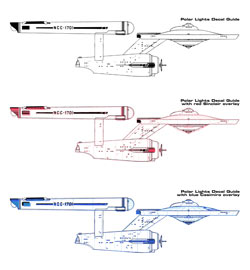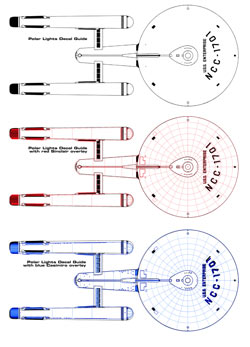Tin_Man,
> Praeter, I don't know why Casimiro's and Sinclair's
> designs differ so much, but the fact that they do
> should serve to remind us how, even in this day
> and age of copious references, just how hard it can
> still be to pin down accurate dimensions to work
> with.
Well, without knowing all the details of their work, I can suggest a few things. First, its a really big model and measuring anything really big with precision is a lot harder than it sounds. Second, its an irregular object, and precise measuring points might not always be available (or amenable to the tools available). Third, unless they had very special access, the model has to be measured suspended in space, which makes performing measurements more difficult. Fourth, the model is imperfect and not symmetrical, so choices end up being made on what is the "correct" measurement. Fifth, experimental error: no matter how careful or what level of precision instruments are used, error tends to creep in.
So, in what might be the best case scenario (under ordinary conditions), you have a couple of guys on ladders swinging measuring tape back and forth over the model. Some people have apparently been able to better than this but they aren't necessarily able to tell us their results. Worst case scenario (but not necessarily a disaster), photographic based measurements are made from a distance.
> And on that last part, are we shure that the space
> behind the dish on the model is actually the way
> Jeffries intended the 'real' ship to be? After all,
> his plans in T.M.O.S.T show some interesting and
> complex machinery there.
Another issue is that the model as it exists today in the Smithsonian is not the model that was filmed. A certain amount of damage and loss appear to have occurred before the model arrived, it took a while before initial repairs were made, and then another "restoration" (IMHO) more or less made matters much worse (in several ways). While the major structural areas are not going to be effected by this, important details will be -- particularly concerning parts that were lost prior to the donation to the Smithsonian. Off the top of my head I don't remember if the deflector was reconstructed or not, for example. I am not assuming that the current conversation is ignoring this issue (or that it is solely, or even primarily, relying on the existing 11' model) -- frankly most of the people I'm listening to here could teach master classes in the topic -- I'm just putting it out there lest we forget that the evidence hasn't undergone a certain amount of tampering.
The other issue is that the ship that MJ designed is probably somewhat different than what was built. Both intentionally and unintentionally. We may or may not discover evidence for this in the details we find along the way in this discussion. It may or may not explain discrepancies among various pieces of evidence.
Just thoughts for consideration.
> Praeter, I don't know why Casimiro's and Sinclair's
> designs differ so much, but the fact that they do
> should serve to remind us how, even in this day
> and age of copious references, just how hard it can
> still be to pin down accurate dimensions to work
> with.
Well, without knowing all the details of their work, I can suggest a few things. First, its a really big model and measuring anything really big with precision is a lot harder than it sounds. Second, its an irregular object, and precise measuring points might not always be available (or amenable to the tools available). Third, unless they had very special access, the model has to be measured suspended in space, which makes performing measurements more difficult. Fourth, the model is imperfect and not symmetrical, so choices end up being made on what is the "correct" measurement. Fifth, experimental error: no matter how careful or what level of precision instruments are used, error tends to creep in.
So, in what might be the best case scenario (under ordinary conditions), you have a couple of guys on ladders swinging measuring tape back and forth over the model. Some people have apparently been able to better than this but they aren't necessarily able to tell us their results. Worst case scenario (but not necessarily a disaster), photographic based measurements are made from a distance.
> And on that last part, are we shure that the space
> behind the dish on the model is actually the way
> Jeffries intended the 'real' ship to be? After all,
> his plans in T.M.O.S.T show some interesting and
> complex machinery there.
Another issue is that the model as it exists today in the Smithsonian is not the model that was filmed. A certain amount of damage and loss appear to have occurred before the model arrived, it took a while before initial repairs were made, and then another "restoration" (IMHO) more or less made matters much worse (in several ways). While the major structural areas are not going to be effected by this, important details will be -- particularly concerning parts that were lost prior to the donation to the Smithsonian. Off the top of my head I don't remember if the deflector was reconstructed or not, for example. I am not assuming that the current conversation is ignoring this issue (or that it is solely, or even primarily, relying on the existing 11' model) -- frankly most of the people I'm listening to here could teach master classes in the topic -- I'm just putting it out there lest we forget that the evidence hasn't undergone a certain amount of tampering.
The other issue is that the ship that MJ designed is probably somewhat different than what was built. Both intentionally and unintentionally. We may or may not discover evidence for this in the details we find along the way in this discussion. It may or may not explain discrepancies among various pieces of evidence.
Just thoughts for consideration.









